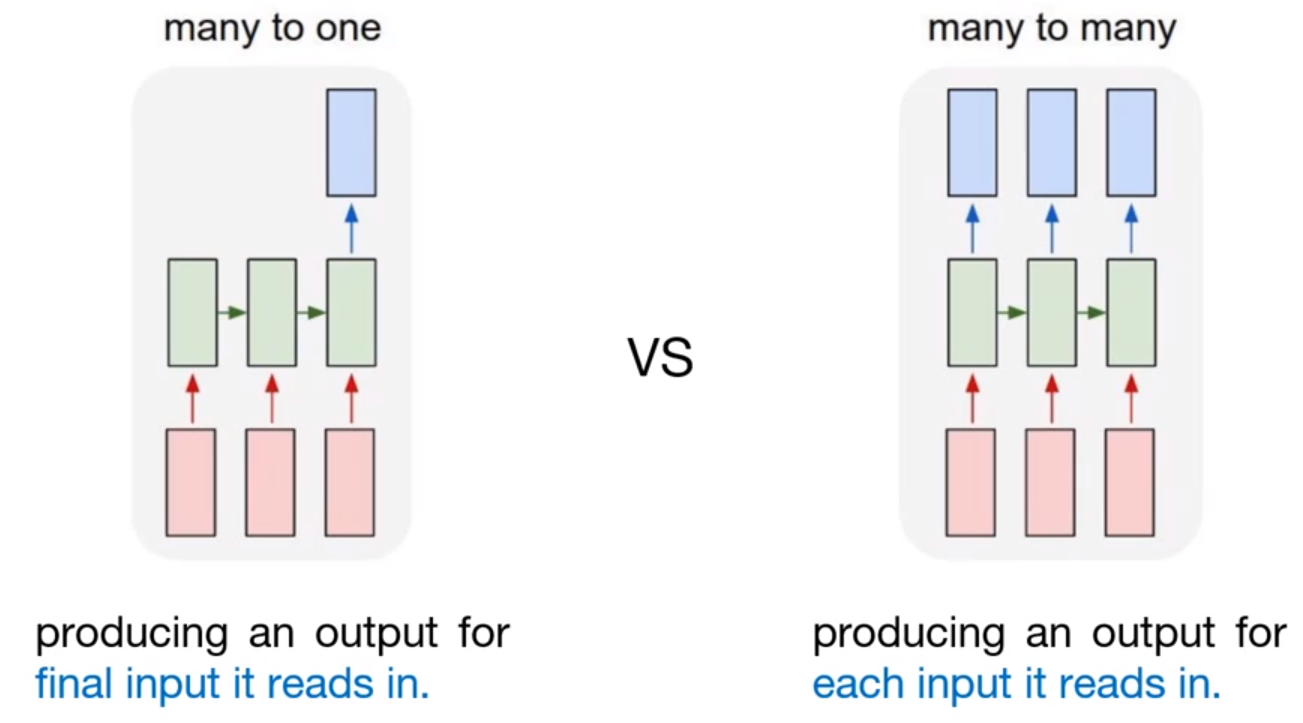RNN - Many-to-many
In this post, We will cover the many-to-many RNN model, which can be used for Part of Speech (POS) tagging and Named Entity Recognition (NER).
import tensorflow as tf
import numpy as np
import matplotlib.pyplot as plt
import pandas as pd
print('Tensorflow: {}'.format(tf.__version__))
plt.rcParams['figure.figsize'] = (16, 10)
plt.rc('font', size=15)
What is "Many-to-many"?
Previously, we covered 3 kinds of RNN model, one-to-one, many-to-one, and many-to-one with stacked model. Especially on many-to-one model, it gets an sequence data as an input, and generates the single output. So it can be used for classification, and previous example shows simple implementation of many-to-one model for word/sequence classification.
Then, what is many-to-many model?
The concept is same as before. In many-to-one model, to generate the output, the final input must be entered into model. Unlike this, many-to-many model generates the output whenever each input is read. That is, many-to-many model can understand the feature of each token in input sequence.

One possible example is Part-of-Speech tagging, POS for short. POS is a category of words (or lexical items) that have similar grammatical properties. Common POS type are noun, verb, adjective, adverb, pronoun, etc. 2. So POS tagging is automatically tagged POS of each token. Of course, it can manually handle with rule-based model, but many-to-many model is appropriate for doing this.
For example, we have a sentence. $$ \text{tensorflow is very easy} $$
In order to do POS tagging, word tokenization is processed on that sentence. After that, we can get
$$ [\text{'tensorflow', 'is', 'very', 'easy'}] $$
Then POS will be tagged on each token like this,
$$[\text{'noun', 'verb', 'adverb', 'adjective'}]$$
If the many-to-many model is well-trained, whole process will be happened well.
Unlike many-to-one model, loss measure is also different in many-to-many model. In many-to-one model, it can measure the loss by comparing the prediction value($\hat{y}$) and actual value($y$). But in many-to-many model, each output node can measure the loss. There are many losses, so common ways to use it for training is by averaging whole losses. This kind of loss is called sequence loss. After that, specific optimizer (SGD or Adam) tries to minimize the loss with backpropagation.
One thing we need to consider is handling padding tokens(' Same as previous example, we can build token dictionary. And additionally, we need to build POS dictionary. We build the dictionary for dataset. Based on this, we can convert from sentence to numerical vector. As you can see, the length of each sentence is various. We can fix the the length with So, here is important section, the loss definition. As we saw before, we need to filter the pad tokens, and calculate the sequence loss with each POS losses. Actually, tensorflow has API for masking. ( We trained the model with 0.003 loss. Then we can enter the X data into the model as an input. To understand the model more visually, we can convert from numerical vector to POS with Through this post, we tried to understand the basic concept of many-to-many RNN model, and how it can used for POS tagging. The main difference from previous ones is the output node is more than 2, not one, and measuring the sequence loss. We simply implement the many-to-many model, and it shows good performance as we expect. (Actually, we need to use validation data, not training data itself for performance measurement.)sentences = [['I', 'feel', 'hungry'],
['tensorflow', 'is', 'very', 'difficult'],
['tensorflow', 'is', 'a', 'framework', 'for', 'deep', 'learning'],
['tensorflow', 'is', 'very', 'fast', 'changing']]
pos = [['pronoun', 'verb', 'adjective'],
['noun', 'verb', 'adverb', 'adjective'],
['noun', 'verb', 'determiner', 'noun', 'preposition', 'adjective', 'noun'],
['noun', 'verb', 'adverb', 'adjective', 'verb']]
word_list =['<pad>'] + sorted(set(sum(sentences, [])))
word2idx = {word:idx for idx, word in enumerate(word_list)}
idx2word = {idx:word for idx, word in enumerate(word_list)}
print(word_list)
print(word2idx)
print(idx2word)
pos_list = ['<pad>'] + sorted(set(sum(pos, [])))
pos2idx = {pos:idx for idx, pos in enumerate(pos_list)}
idx2pos = {idx:pos for idx, pos in enumerate(pos_list)}
print(pos_list)
print(pos2idx)
print(idx2pos)
X = list(map(lambda sentence: [word2idx.get(token) for token in sentence], sentences))
y = list(map(lambda sentence: [pos2idx.get(token) for token in sentence], pos))
print(X)
print(y)
pad_sequences. Also, we need masking vector for filtering pad tokens. In order to this, we feed the length of each sentence without padding as an input.from tensorflow.keras.preprocessing.sequence import pad_sequences
X = pad_sequences(X, maxlen=10, padding='post')
X_mask = (X != 0).astype(np.float32)
X_len = np.array(list((map(lambda sentence: len(sentence), sentences))), dtype=np.float32)
print(X)
print(X_mask)
print(X_len)
y = pad_sequences(y, maxlen=10, padding='post')
print(y)
train_ds = tf.data.Dataset.from_tensor_slices((X, y, X_len)).shuffle(buffer_size=4).batch(batch_size=2)
print(train_ds)
num_classes = len(pos2idx)
input_dim = len(word2idx)
output_dim = len(word2idx)
from tensorflow.keras.models import Sequential
from tensorflow.keras.layers import Embedding, TimeDistributed, Dense, SimpleRNN
model = Sequential([
Embedding(input_dim=input_dim, output_dim=output_dim,
mask_zero=True, trainable=False, input_length=10,
embeddings_initializer=tf.keras.initializers.random_normal()),
SimpleRNN(units=10, return_sequences=True),
TimeDistributed(Dense(units=num_classes))
])
model.summary()
sequence_mask)def loss_fn(model, x, y, x_len, max_sequence):
masking = tf.sequence_mask(x_len, maxlen=max_sequence, dtype=tf.float32)
sequence_loss = tf.keras.losses.sparse_categorical_crossentropy(
y_true=y, y_pred=model(x), from_logits=True
) * masking
sequence_loss = tf.reduce_mean(tf.reduce_sum(sequence_loss, axis=1) / x_len)
return sequence_loss
optimizer = tf.keras.optimizers.Adam(learning_rate=0.1)
tr_loss_hist = []
for e in range(30):
avg_tr_loss = 0
tr_step = 0
for x_mb, y_mb, x_mb_len in train_ds:
with tf.GradientTape() as tape:
tr_loss = loss_fn(model, x_mb, y_mb, x_mb_len, max_sequence=10)
grads = tape.gradient(tr_loss, model.trainable_variables)
optimizer.apply_gradients(grads_and_vars=zip(grads, model.trainable_variables))
avg_tr_loss += tr_loss
tr_step += 1
avg_tr_loss /= tr_step
tr_loss_hist.append(avg_tr_loss)
if (e + 1) % 5 == 0:
print('Epoch: {:3}, tr_loss: {:.3f}'.format(e+1, avg_tr_loss))
y_pred = model.predict(X)
y_pred = np.argmax(y_pred, axis=-1) * X_mask
y_pred
idx2pos dictionary.from pprint import pprint
y_pred_pos = list(map(lambda row: [idx2pos.get(elm) for elm in row], y_pred.astype(np.int32).tolist()))
pprint(y_pred_pos)
pprint(pos)
plt.figure()
plt.plot(tr_loss_hist)
plt.title('Training loss for many-to-many model')
plt.show()
Summary
